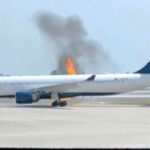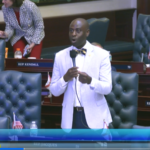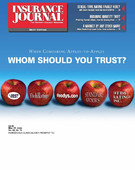Two recently released studies on trends in automobile insurance rates show a wide variation in the cost for coverage across the nation. At first glance, they also seem to show a big discrepancy in their findings. It turns out, however, that although they’re not exactly comparing apples to oranges, they do consider different criteria in determining what auto insurance costs are.
For example, the latest analysis by Rochester, Wis.-based consulting firm, Runzheimer International, shows that the lowest annual premium, $978, can be found in Nashville, Tenn.
However, a recent report by the Insurance Information Institute (I.I.I.) indicates that the average cost for auto insurance for 2004 in the United States is estimated at $871, a $29 increase over last year’s average and $17 lower than Runzheimer’s lowest annual premium.
The difference is that Runzheimer’s study is based on premium rates for both male and female drivers over a minimum age with clean driving records and include full coverage—comprehensive, collision, bodily injury, property damage and uninsured motorist coverage, and the I.I.I.’s analysis looks at amounts that people actually pay for insurance across the country. And what they pay for is not necessarily the breadth of coverage upon which Runzheimer bases its study.
“I’m looking at what people are actually buying,” I.I.I. chief economist, Robert Hartwig, said. His figures do not reflect the average premium, because the average liability piece and the average property piece are different.
“A lot of people don’t buy everything,” Hartwig said. He noted that in areas of the country that have high auto insurance costs, such as Detroit, many people, if not most, buy less coverage than is available.
According to Runzheimer, Detroit was the costliest city in the United States for auto insurance last year. The average premium for all-inclusive coverage was $4,945 per year for a mid-size sedan driven within a 50-mile radius of the city.
The good news is that the country can expect smaller rate increases in 2004 than it has seen in the past few years, the I.I.I. reported. The cost of auto insurance is expected to rise by 3.5 percent in 2004, the smallest increase in four years.
Rates rose nationwide an average 7.8 percent in 2003 compared to 8.8 percent in 2002. The trend toward smaller increases is being driven by a declining number of auto accidents, as well as crackdowns on fraud and abuse. However, rising costs for medical care, vehicle repairs and massive jury awards continue to cause problems.
“A reduction in auto accidents, combined with improved insurer financial performance, are contributing to a significant moderation in the cost of auto insurance in 2004,” Hartwig said. “Some drivers are even seeing rate decreases, especially those with the best driving records.”
Still, motorists in some states, such as Florida, Massachusetts and New York can expect costs to remain high due to increases in automobile theft rates and fraud, according to the I.I.I.
Runzheimer’s study also shows that conditions in various parts of the country affect how much a consumer will actually pay.
“There’s really no mystery here,” according to David Freidlen, Runzheimer’s product development director and vehicle cost expert. “Insurance companies set rates based on claims records. Fewer accidents, vehicle thefts and collision damage repair bills in Nashville versus Detroit translate into much lower annual insurance premiums.”
Although fewer claims are being submitted, “those that are filed cost more,” Hartwig stated. “It costs more to repair cars, particularly following accidents involving sport utility vehicles.”
Higher costs for hospitalization and pharmaceuticals, state regulations that permit abuse of medical treatments and associated legal costs are countering lower accident frequency rates, Hartwig added. He estimated insurers will pay between $15 billion and $20 billion in medical claims in 2004.
In addition to medical costs and higher repair bills, higher jury awards in vehicular liability cases are putting additional upward pressure on auto insurance rates.
“Auto liability issues are much more important than people realize,” Hartwig noted. “About 60 percent of auto premiums paid in 2003—more than $80 billion—were for liability coverage. As we look at 2004 and into 2005, we see this trend continuing.”
Auto theft is another significant factor that affects rates. Preliminary data from the Federal Bureau of Investigation’s Uniform Crime Report show the number of auto thefts rose by 0.9 percent during the first half of 2003, the latest period for which data are available. This follows a 1.4 percent increase in auto thefts in 2002, 5.9 percent in 2001 and 0.7 percent in 2000. An estimated 1.25 million auto thefts were reported in 2002.
The West and South experienced the highest number of thefts in the nation, with the lowest rates occurring in the Midwest and Northeast. The largest increases in auto theft were reported in medium-size cities and suburban areas.
High, low and in-between
According to Runzheimer’s study, in addition to Detroit, the metropolitan areas with the most expensive car insurance premiums are: Philadelphia, Pa. ($3,666); Newark, N.J. ($3,557); Los Angeles ($3,258); and New York City at $2,762. New Orleans came in sixth place with an average annual premium of $2,539.
After Nashville, the areas with the lowest average premiums for the all-inclusive coverage include: Boise, Idaho ($990); Richmond, Va. ($1,038); Burlington, Vt. ($1,039); and Evansville, Ind. ($1,045).
Rates for some of the South Central cities in Runzheimer’s study include: Little Rock, Ark. ($1,268); Oklahoma City ($1,753); and Dallas ($1,390), Houston ($1,317) and Austin, Texas ($1,158).
Was this article valuable?
Here are more articles you may enjoy.


 Delta Plane Catches Fire at Orlando Airport in Latest Incident for Airline
Delta Plane Catches Fire at Orlando Airport in Latest Incident for Airline  Dog Bite Claims Soar in Frequency and Cost: Report
Dog Bite Claims Soar in Frequency and Cost: Report  Did Florida House ‘Sneak’ Attorney Fee Wording Into Phosphate Mine Bill?
Did Florida House ‘Sneak’ Attorney Fee Wording Into Phosphate Mine Bill?  Insurance Groups Celebrate Signing of Georgia Tort Reform Laws
Insurance Groups Celebrate Signing of Georgia Tort Reform Laws 


